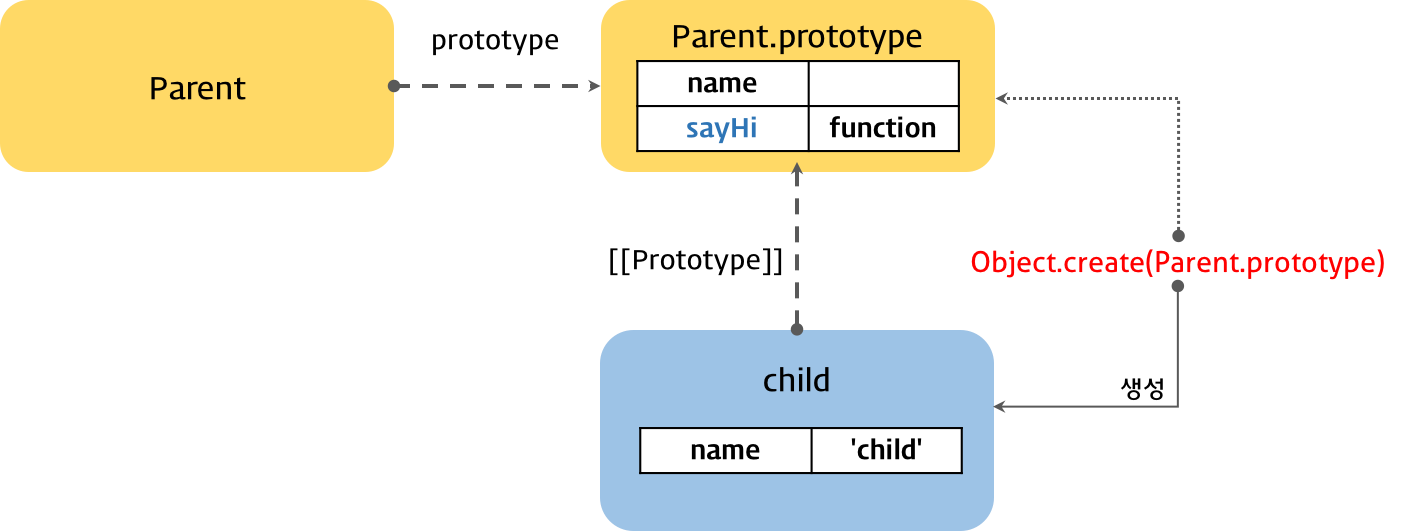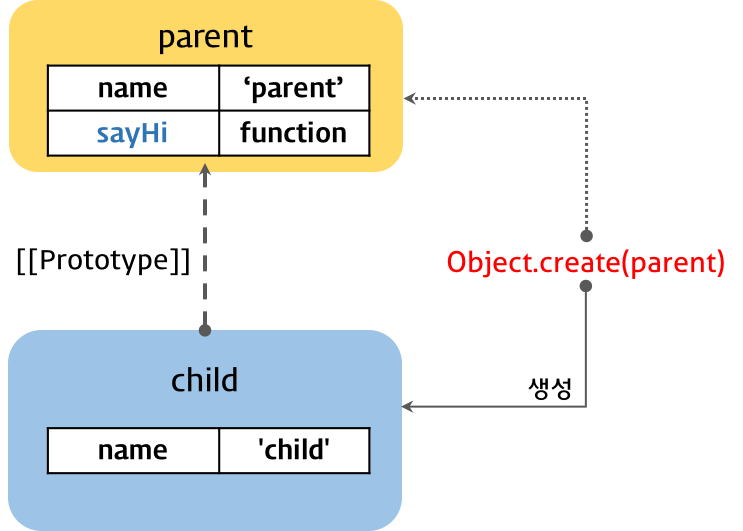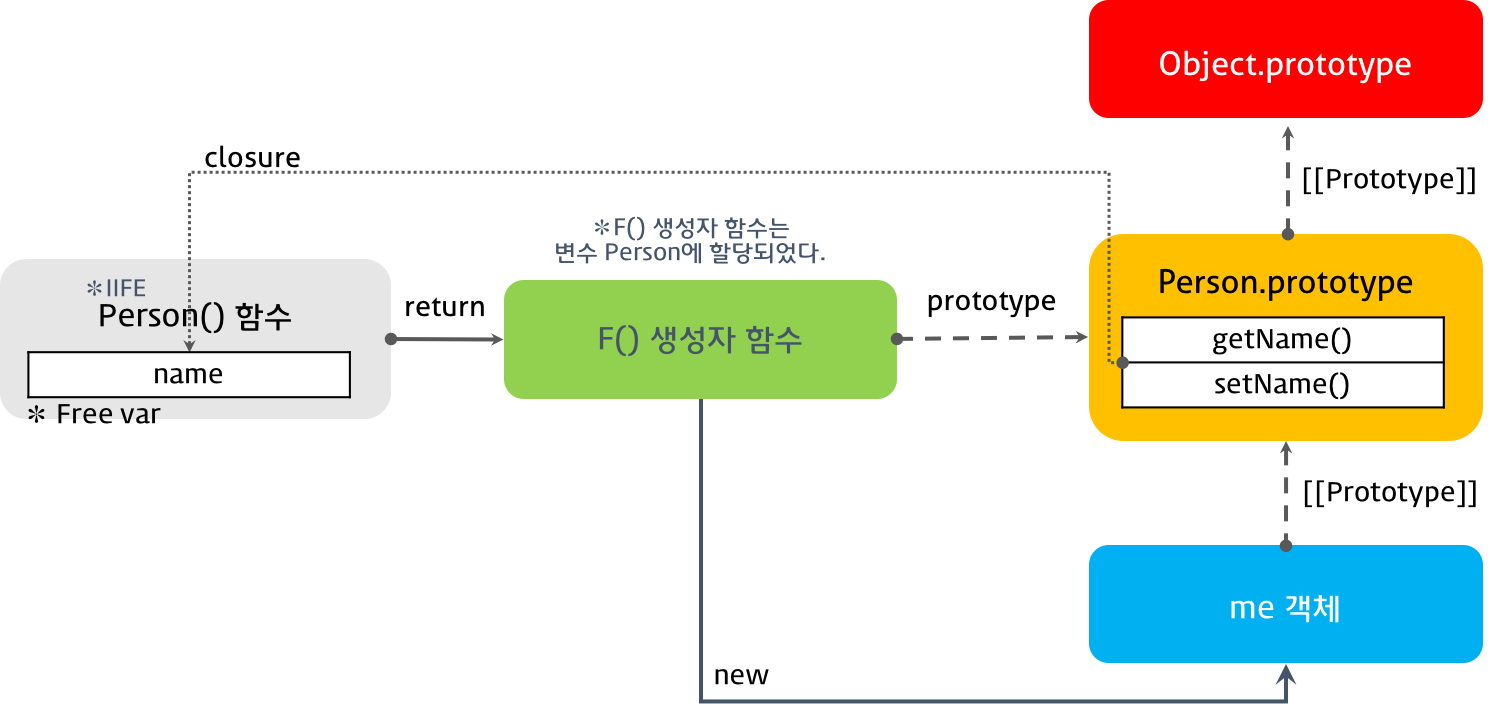1. 상속 (Inheritance)
클래스 기반 언어에서 객체는 클래스의 인스턴스이며 클래스는 다른 클래스로 상속될 수 있다. 자바스크립트는 기본적으로 프로토타입을 통해 상속을 구현한다. 이것은 프로토타입을 통해 객체가 다른 객체로 직접 상속된다는 의미이다. 이러한 점이 자바스크립트의 약점으로 여겨지기도 하지만 프로토타입 상속 모델은 사실 클래스 기반보다 강력한 방법이다.
자바스크립트의 상속 구현 방식은 크게 두 가지로 구분할 수 있다. 하나는 클래스 기반 언어의 상속 방식을 흉내 내는 것(의사 클래스 패턴 상속. Pseudo-classical Inheritance)이고, 두번째는 프로토타입으로 상속을 구현하는 것(프로토타입 패턴 상속. Prototypal Inheritance)이다.
2.1 의사 클래스 패턴 상속 (Pseudo-classical Inheritance)
의사 클래스 패턴은 자식 생성자 함수의 prototype 프로퍼티를 부모 생성자 함수의 인스턴스로 교체하여 상속을 구현하는 방법이다. 부모와 자식 모두 생성자 함수를 정의하여야 한다.
// 부모 생성자 함수
var Parent = (function () {
// Constructor
function Parent(name) {
this.name = name;
}
// method
Parent.prototype.sayHi = function () {
console.log('Hi! ' + this.name);
};
// return constructor
return Parent;
}());
// 자식 생성자 함수
var Child = (function () {
// Constructor
function Child(name) {
this.name = name;
}
// 자식 생성자 함수의 프로토타입 객체를 부모 생성자 함수의 인스턴스로 교체.
Child.prototype = new Parent(); // ②
// 메소드 오버라이드
Child.prototype.sayHi = function () {
console.log('안녕하세요! ' + this.name);
};
// sayBye 메소드는 Parent 생성자함수의 인스턴스에 위치된다
Child.prototype.sayBye = function () {
console.log('안녕히가세요! ' + this.name);
};
// return constructor
return Child;
}());
var child = new Child('child'); // ①
console.log(child); // Parent { name: 'child' }
console.log(Child.prototype); // Parent { name: undefined, sayHi: [Function], sayBye: [Function] }
child.sayHi(); // 안녕하세요! child
child.sayBye(); // 안녕히가세요! child
console.log(child instanceof Parent); // true
console.log(child instanceof Child); // trueChild 생성자 함수가 생성한 인스턴스 child(①) 의 프로토타입 객체는 Parent 생성자 함수가 생성한 인스턴스(②)이다. 그리고 Parent 생성자 함수가 생성한 인스턴스의 프로토타입 객체는 Parent.prototype이다.
이로써 child는 프로토타입 체인에 의해 Parent 생성자 함수가 생성한 인스턴스와 Parent.prototype의 모든 프로퍼티에 접근할 수 있게 되었다. 이름은 의사 클래스 패턴 상속이지만 내부에서는 프로토타입을 사용하는 것은 변함이 없다.

문제점
1. new 연산자를 통해 인스턴스를 생성한다.
생성자 함수의 사용에는 심각한 위험이 존재한다. 만약 생성자 함수를 호출할 때 new 연산자를 포함하는 것을 잊게 되면 this는 새로운 객체와 바인딩되지 않고 전역객체에 바인딩된다.
2. 생성자 링크의 파괴
위 그림을 보면 child 객체의 프로토타입 객체는 Parent 생성자 함수가 생성한 new Parent() 객체이다.
기본적으로 프로토타입 객체는 내부 프로퍼티로 constructor를 가지며 이는 생성자 함수를 가리킨다.하지만 의사 클래스 패턴 상속은 프로토타입 객체를 인스턴스로 교체하는 과정에서 constructor의 연결이 깨지게 된다.
즉, child 객체를 생성한 것은 Child 생성자 함수이지만 child.constructor의 출력 결과는 Child 생성자 함수가 아닌 Parent 생성자 함수를 나타낸다. 이는 child 객체의 프로토타입 객체인 new Parent() 객체는 constructor가 없기 때문에 프로토타입 체인에 의해 Parent.prototype의 constructor를 참조했기 때문이다.
console.log(child.constructor); // [Function: Parent]
3. 객체리터럴
의사 클래스 패턴 상속은 기본적으로 생성자 함수를 사용하기 때문에 객체리터럴 패턴으로 생성한 객체의 상속에는 적합하지 않다. 이는 객체리터럴 패턴으로 생성한 객체의 생성자 함수는 Object()이고 이를 변경할 방법이 없기 때문이다.
1.2 프로토타입 패턴 상속 (Prototypal Inheritance)
프로토타입 패턴 상속은 Object.create 함수를 사용하여 객체에서 다른 객체로 직접 상속을 구현하는 방식이다. 프로토타입 패턴 상속은 개념적으로 의사 클래스 패턴 상속보다 더 간단하다. 또한 의사 클래스 패턴의 단점인 new 연산자가 필요없으며, 생성자 링크도 파괴되지 않으며, 객체리터럴에도 사용할 수 있다.
생성자 함수를 사용한 프로토타입 패턴 상속
// 부모 생성자 함수
var Parent = (function () {
// Constructor
function Parent(name) {
this.name = name;
}
// method
Parent.prototype.sayHi = function () {
console.log('Hi! ' + this.name);
};
// return constructor
return Parent;
}());
// create 함수의 인수는 프로토타입이다.
var child = Object.create(Parent.prototype);
child.name = 'child';
child.sayHi(); // Hi! child
console.log(child instanceof Parent); // true
객체리터럴 패턴 객체의 프로토타입 패턴 상속
var parent = {
name: 'parent',
sayHi: function() {
console.log('Hi! ' + this.name);
}
};
// create 함수의 인자는 객체이다.
var child = Object.create(parent);
child.name = 'child';
// var child = Object.create(parent, {name: {value: 'child'}});
parent.sayHi(); // Hi! parent
child.sayHi(); // Hi! child
console.log(parent.isPrototypeOf(child)); // true
Object.create 함수는 매개변수에 프로토타입으로 설정할 객체 또는 인스턴스를 전달하고 이를 상속하는 새로운 객체를 생성한다. Object.create 함수는 표준에 비교적 늦게 추가되어 IE9 이상에서 정상적으로 동작한다. 따라서 크로스 브라우징에 주의하여야 한다.
2. 캡슐화(Encapsulation)와 모듈 패턴(Module Pattern)
캡슐화는 관련있는 멤버 변수와 메소드를 클래스와 같은 하나의 틀 안에 담고 외부에 공개될 필요가 없는 정보는 숨기는 것을 말하며 다른 말로 정보 은닉(information hiding)이라고 한다.
Java의 경우, 클래스를 정의하고 그 클래스를 구성하는 멤버에 대하여 public 또는 private 등으로 한정할 수 있다. public으로 선언된 메소드 또는 데이터는 외부에서 사용이 가능하며, private으로 선언된 경우는 외부에서 참조할 수 없고 내부에서만 사용된다.
하지만 자바스크립트는 public 또는 private 등의 키워드를 제공하지 않는다. 하지만 정보 은닉이 불가능한 것은 아니다.
기본적인 형태
var Person = function(arg) {
var name = arg ? arg : ''; // ①
this.getName = function() {
return name;
};
this.setName = function(arg) {
name = arg;
};
}
var me = new Person('Lee');
var name = me.getName();
console.log(name); // 'Lee'
me.setName('Kim');
name = me.getName();
console.log(name); // 'Kim'
①의 name 변수는 private 변수가 된다. 자바스크립트는 function-level scope를 제공하므로 함수 내의 변수는 외부에서 참조할 수 없다. 만약에 var 대신 this 를 사용하면 public 멤버가 된다.
만약 new 키워드로 객체를 생성하지 않으면 this는 생성된 객체에 바인딩되지 않고 전역객체에 연결된다.
그리고 public 메소드 getName, setName은 클로저로서 private 변수(자유 변수)에 접근할 수 있다. 이것이 기본적인 정보 은닉 방법이다.
모듈 패턴
var person = function(arg) {
var name = arg ? arg : '';
return {
getName: function() {
return name;
},
setName: function(arg) {
name = arg;
}
}
}
var me = person('Lee'); /* or var me = new person('Lee'); */
var name = me.getName();
console.log(name); // 'Lee'
me.setName('Kim');
name = me.getName();
console.log(name); // 'Kim'
console.log(person.prototype === me.__proto__); // false
console.log(me.__proto__ === Object.prototype); // true: 객체 리터럴 방식으로 생성된 객체와 동일하다
person 함수는 객체를 반환한다. 이 객체 내의 메소드 getName, setName은 클로저로서 private 변수 name에 접근할 수 있다. 많은 라이브러리에서 사용되는 유용한 패턴이다.
private 멤버가 객체나 배열일 경우, 참조값을 반환하므로 반환된 해당 멤버의 변경이 가능하다. 이를 회피하기 위해서는 객체를 그대로 반환하지 않고 반환해야 할 객체의 정보를 새로운 객체에 담아 반환해야 한다.
위 모듈 패턴은 생성자 함수가 아니며 단순히 메소드를 담은 객체를 반환한다. 반환된 객체는 객체 리터럴 방식으로 생성된 객체로 함수 person의 프로토타입에 접근할 수 없다.
모듈패턴 개선버전 (생성자 함수 반환 형태)
var Person = function(arg) {
var name;
var F = function(arg) { name = arg ? arg : ''; };
F.prototype = {
getName: function() {
return name;
},
setName: function(arg) {
name = arg;
}
};
return F;
}();
var me = new Person('Lee');
console.log(Person.prototype === me.__proto__);
console.log(me.getName());
me.setName('Kim')
console.log(me.getName());
참고
'JS > JS 공부는 다다익선 [모던자바스크립트]' 카테고리의 다른 글
| JS 공부는 다다익선 - 13. REST API (0) | 2023.10.06 |
|---|---|
| JS 공부는 다다익선 - 12. 이벤트 (0) | 2023.10.04 |
| JS 공부는 다다익선 - 10. 클로저(closure) (0) | 2023.09.28 |
| JS 공부는 다다익선 - 9. 함수 호출과 this (0) | 2023.09.28 |
| JS 공부는 다다익선 - 8. 스코프(Scope) (0) | 2023.09.22 |



